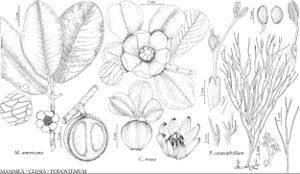Mammea americana
Sp. Pl. 1: 512. 1753.
Trees often narrow and densely leafy, to 15 (–20) m. Leaves: petiole stout, 10–15 mm; blade dark green, elliptic to obovate-elliptic, 9–25 × 5–11 cm, base cuneate to rounded, apex obtuse to rounded or retuse, tertiary reticulation dense. Inflorescences 3+-flowered (staminate) or 1-flowered (pistillate or bisexual). Pedicels 5–15 mm. Flowers: sepals orbiculate-concave, 1–1.5 × 1–1.5 cm; petals 4–6, imbricate, white, orbiculate, 1.5–2.5 cm; filaments basally expanded; ovary pyriform. Berries brown, globose or subglobose, 10–15 cm diam.; mesocarp fleshy, soft when ripe; endocarp reddish-brown, fibrous. Seeds to 7 × 5.5 cm.
Phenology: Flowering summer–fall (May–Oct).
Habitat: Wetlands
Elevation: 0–40 m
Distribution

Introduced; Fla., Mexico, West Indies (Greater Antilles), West Indies (St. Croix), West Indies (St. Thomas), West Indies (Trinidad), Central America
Discussion
Mammea americana is widely grown for fruit and occasionally naturalized in southern Florida (Miami-Dade County and keys).
Selected References
None.
